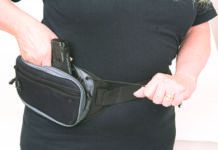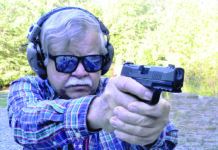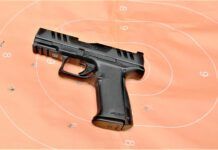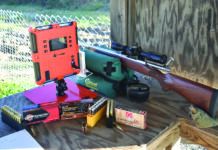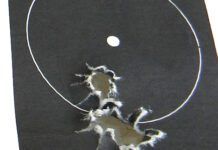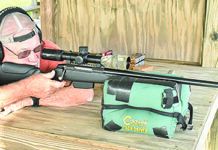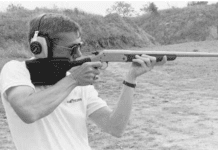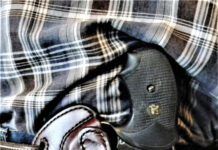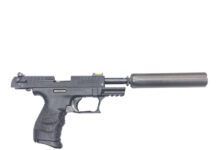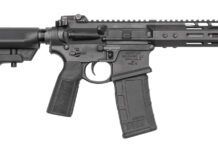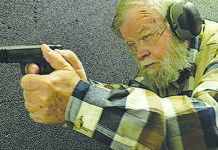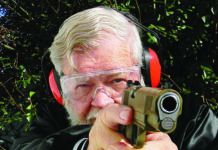If the last time you tuned in to the world of rimfire ammunition the .17 Hornady Magnum Rimfire (HMR) was all the rage, then you probably missed the arrival of Hornady’s .17 Mach 2 cartridge. The year was 2004, and the difference between the two rounds is this. Just as the .17 HMR can be described as being descended from the .22 Magnum, the .17M2 is related to the .22 Long Rifle—the .17M2 is based on the .22 LR case, slightly lengthened and necked down to .17 caliber. Photographed close up, the .17M2 looks remarkably like a full-size centerfire round, but it’s nearly small enough to be hidden beneath a quarter. The .17M2 round does not develop the velocity of .17 HMR ammunition (by about 350 fps on average), but it still offers a very flat trajectory and the advantage of the modern .17 caliber bullet is touted as being more accurate than traditional rimfire slugs.
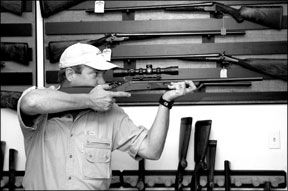
To experience shooting .17 Mach 2 rounds from behind the trigger, we acquired three rifles. They were the $169 New England Firearms Sportster SS1-217, Marlin’s $232 917M2, and the $228 Savage Arms Mark II F. The Marlin and Savage Arms rifles were magazine-fed bolt actions, and the NEF worked from a single-shot break-top design.
Each rifle arrived ready for the mounting of a scope, and we tried several in our initial range session. Considering the low cost of our test rifles, we preferred not to choose a scope that cost more than our most expensive model. We lucked out with the $100 Konus Pro 1.5-5X32mm No. 7249 (konusscopes.com). The Konus Pro offered an etched glass-reticle that gave us plenty of light, and it featured fine crosshairs centered inside of a diamond pattern. We liked this because we didn’t want the crosshairs to obscure any more target mass than necessary. In the field we thought the diamond helped us get on target more quickly, and variable power offered added flexibility to our field of view.
We tested with the only three .17M2 rounds we could find. They were Remington’s AccuTip V Boat tail, CCI’s V-Max and Hornady’s V-Max. All three were sold in 50-round boxes and were topped with 17-grain bullets. Prices ranged from $7 for the CCI to $11 for the Hornady in our local store.
Our targets were 6-inch Target Spots by Birchwood Casey. These orange adhesive circles featured a diamond-shaped bull that matched well with the diamond reticle of the Konus Pro scope. Shooting at American Shooting Centers in Houston (amshootcenters.com), we began our benchrest session by recording five-shot groups from a distance of 50 yards with each test round. Next, we tried printing groups from 100 yards with whichever round proved the best in each individual rifle. Each gun was tested under conditions that varied from calm winds and bright sunlight to 25-mph winds that periodically moved clouds in front of the sun. For support, we used a heavy Caldwell Tack Driver bag up front and a bean bag underneath the stock. Here is what we learned.
New England FirearmsSportster SS1-217.17 Mach 2, $169
As of November 2000 the company names and assets attached to New England Firearms and Harrington & Richardson became the property of Marlin Firearms. This makes Marlin Firearms, marketing its products under the brand names of Harrington & Richardson and New England Firearms, H&R 1871 LLC, the largest manufacturer of single-shot shotgun and rifles in the world.
Our NEF rifle was about as simple to operate as any rifle can be, but it did have some up-to-date features. The black synthetic stock was backed by a thick ventilated rubber pad. The comb met the shooter’s cheek with a Monte Carlo-style contour. A pebble finish covered its entire surface. We found the grip end of the stock mated flush to the right-hand side of the flat-black colored receiver, but the left-hand side was slightly offset. The manufacturer said that this was not a palm swell or similar feature but actually a manufacturing defect. If we were dissatisfied, they were willing to apply a new stock. But since it didn’t really look out of place or affect function, we were willing to let it pass. The forend showed a black pebble finish to match the stock and offered an indentation for grip immediately below the flush-fitting heavy varmint barrel. Fixed studs for attaching a sling were mounted front and rear. The outer diameter of the barrel was almost five times its bore, and its outer surface showed a gleaming brushed pattern of vertical lines. A 5-inch-long scope mount was seated atop the barrel with its edge nearly flush with the chamber end of the barrel.
The hr1871.com website lists several different series of rifles and at least six different lines that operate from the same basic system. The Sportster series consists of five different models each chambered for rimfire calibers only. Extra barrels that change the caliber are available from the factory. There were only three operational features on the NEF Sportser. They were the trigger, which broke cleanly at 4 pounds every time, the hammer, and the barrel release.
Pushing in the barrel release automatically ejected the shell. As advised in the owner’s manual, we found it best to dismount the cheek from the stock prior to ejection to avoid getting smacked by the empty case as it rocketed out of the chamber. A transfer-bar system was in place to help prevent accidental ignition. The transfer bar fills the gap between the face of the hammer and the firing pin. Unless the trigger was pressed, the transfer bar remained in the down position. The resulting gap prevented the firing pin from being struck.
Of the four Sportster models, only the .22-caliber rifles are shipped with sights. But both the .17 HMR and .17 Mach 2 rifles ship with a Weaver mount in place. The scope mount was tall, but the supplied extension had to be mounted on to the tang of the hammer. This part was waiting for us in a plastic bag glued securely to a fold inside the corrugated shipping box. The extension slipped over the tang and made it possible to pull back the hammer from the side. The extension can be mounted to provide access from either the left- or right-hand side. Even with the barrel release offset to the right, we would judge this rifle to be equal in favor of right- or left-handed shooters. The extension was tubular with a checkered outer surface. Inside the extension was an Allen set screw that was remarkably hard to turn. But we didn’t strip the screw or the wrench, and the tight fit made the application of Loc-Tite unnecessary.
We found that the $21 Burris Zee rings that worked so well on our other two rifles were too tight for the Weaver mount atop the NEF Sportster. We resorted to using a set of Traditions-brand rings we found in a hardware store selling for about $8. These aluminum rings worked perfectly well and we were able to mount our Konus Pro scope just above the hammer. Having pieced together a truly budget rifle, we headed for the range.
Mounting the NEF Sportster for our bench session was easy because without a magazine protruding from the bottom of the receiver, we could support as much of the rifle as we wanted on to our sandbags. This freed up our position and helped us avoid such pitfalls such as pressing the front of the magazine against the sandbag. This also trimmed its profile for more comfortable carry when slung over-the-shoulder. We also enjoyed carrying the Sportster cracked open with one hand cupped beneath the action. This point of balance made the gun feel lighter than its 7+ pounds.
From the 50-yard line, the NEF Sportster was the top performer. The barrel never seemed to heat up, and performance was consistent. We only printed one five-shot group that measured as much as a full inch across. Groups measuring less than a half inch were printed with both the Hornady and Remington ammunition. From the 100-yard bench, our groups averaged 1.8 inches across firing the Hornady ammunition, mainly due to one 2.2-inch cluster. Our tightest five-shot group at this distance measured 1.3 inches across. We never thought a single-shot rifle could be so enjoyable.
Marlin 917M2 .17 Mach 2, $232
Marlin offers two different rifles chambered for .17 Mach 2 under its own name. One is the 717M2, which is an autoloader with an 18-inch barrel, and the other is our bolt-action test rifle that fired from a 22-inch barrel. Of our two bolt-action rifles, the Marlin 917M2 was distinguished by its wooden stock and heavy 1:9 twist barrel. The stock featured a walnut hardwood finish with traditional diamond patterning embossed on the forend and upon the slender pistol grip. The stock was one piece completely enveloping the action but left about five dollar bills width of float beneath the barrel. The buttplate was plastic but carried some nice patterning, and it was machined to fit the stock precisely. The stock was somewhat slender end to end, but did offer a Monte Carlo profile. Fixed sling studs were in place forward and aft. One seven-round magazine was supplied.
Our 917M2 arrived without sights, but the receiver was drilled and tapped for a two-piece scope mount. The holes were plugged with blind screws. A sealed envelope containing two single cross-hatch Weaver mounts and slotted screws for mounting were enclosed. This reminded us of a Remington 700. In fact, despite its slender stock and the less than convincing faux checkering, the 917M2 gave us the impression of being a full-size centerfire rifle.
The barrel was just as heavy as the NEF’s. The stock was inlet with economy and precision, giving the bolt and the lever-style safety a purposeful look. The bolt knob offered a classic battle rifle feel, and its stem was shaved at its bend to accommodate a sizable scope. The action was smooth and offered a pleasing blue gloss. The safety worked with a reassuring on/off click. The magazine release was not fancy, but the edges of the pull back bar were radiused and smooth. Care had been taken throughout so that none of the edges were rough. The trigger offered a long radius with vertical grooves across its moderately wide face. Ignition was achieved after applying 5.5 pounds of pressure. This was heavier than our other rifles, but none of it was wasted on takeup or grit.
From the 50-yard bench the Marlin 917M2 helped us shoot groups ranging in size from 0.6 inches to 1.0 inches across with both the Hornady and CCI ammunition. All groups firing the Remington ammunition measured about 0.9 inches, so we tried shooting the Remington Accutip V boattails from the 100-yard bench. Groups ranged in size from 1.1 to 1.9 inches. This was the best performance at this distance, on average, among our three rifles, but results were close. We would rank gusting wind as the greatest agitate to accurate long distance shots.
We liked the Marlin 917M2 because it was a pleasure to shoot an inexpensive bolt action rifle that handled and performed like a much bigger gun.
Savage Arms Mark II F, $228
Thirteen different models chambered for .17-caliber ammunition are available from Savage Arms. But eleven of these rifles are chambered for .17 HMR. The two .17M2 models on the slate are the Mark II F and the Mark II FV, signifying a heavy varmint barrel such as the ones found on our other two rifles. We couldn’t help but notice that the current savagearms.com website showed each of these models with the AccuTrigger. But our test rifle was equipped with a standard action and trigger, which hurt it in this comparison.
Rounds were fed via a 10-round curved magazine with polymer follower. The magazine body was constructed of five different plates stamped and notched together. The magazine release consisted of a sheet metal tab that was pulled to the rear to disengage. The black synthetic stock was flat across the comb with a thin pistol grip that, like the forend area, offered a traditional pattern of checkering. Otherwise, the surface was evenly pebbled. There was quite a bit of flex and gap between the forend and the barrel, so there appeared to be an effective float between the barrel and the stock.
The trigger guard was molded as part of the stock. There was a manual safety similar to the Marlin design, but its operation was somewhat “notchy,” if not just as secure. The bolt action was smooth, and we could hear a zipping sound as it moved back and forth. We noticed that the throw of the bolt on the Mark II F was shorter than the Marlin action by almost one third, (approximately 1.2 inches versus about 1.55 inches). The sound of the bolt stop rang through the hollow cavity of the synthetic stock. A two-piece scope mount was in place when we opened the box.
At the range we discovered that the trigger had a mixture of takeup and creep. That is, when we first started firing we would begin our press, only to be fooled by a period of grit and creep that coaxed us to stall or stop our movement. We also noticed that the trigger did have some play side to side. After about 100 rounds the trigger became more consistent. But the sequence was still less than ideal. Applying pressure we would engage a gritty takeup that would stall our finger. We then would press through to overcome this ersatz second stage.
If the trigger was becoming more predictable with each shot, we had to pace ourselves. Our heavy barreled rifles did not seem to have a problem with heat, but our Mark II F heated up quickly after just a few shots. The difference in accuracy delivered by a cool barrel, and shots fired from a hot one was noticeable. Our opinion is that we would favor the Mark II FV with heavy barrel to minimize this problem even if the thinner barreled rifle was lighter to carry and perhaps more suitable to younger folk.
Throughout our tests we were only able to print one group with this gun that measured less than 1 inch across from the 50-yard line. Our 100-yard shots were the last groups fired, and they weren’t as bad as we would have expected judging from our initial efforts. In fact we shot the Mark II F more than our other rifles if for no other reason than to find out if the trigger would get better or significantly worse. Along the way we did suffer some misfires and failures to eject. But the trigger did wear in, and if it never smoothed out, at least it became more predictable. Groups fired from 100 yards with the Remington ammunition ranged from 1.6 inches to 2.0 inches across. Equipped with the AccuTrigger, we think the Mark II F would be a much better rifle.


